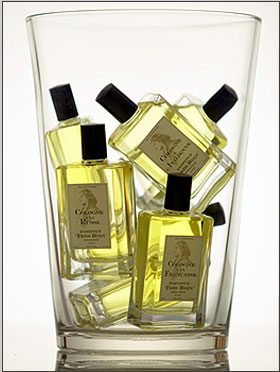Perfume Review & Musings: Eau de Cologne à La Russe, à La Française & à l'Italienne by Pierre Bourdon for Institut Très Bien

On a recent trip to Paris I came accross a line of niche colognes that I think have good chances of pleasing amateurs of refined and understated fragrances as well as potentially proving to be a welcome addition to the fragrance wardrobes of people who are looking for fumes discrete enough to wear at the office. They will also probably pique the curiosity of history buffs and rejoice Europeanophiles....
The line is by Institut Très Bien, a perfume house located in Lyon, France. It comprises three perfumes called Cologne à La Russe, Cologne à La Française, and Cologne à L'italienne with each cologne pertaining to a specific style identified with a country and historical cologne tradition. Their names mean Cologne Russian Style, etc.
They are by no means your simple, middle-of-the-road colognes. They were created or partly recreated by nose Pierre Bourdon who is also for example the author of Shiseido Féminité du Bois (together with Chris Sheldrake) and of Iris Poudre by Frederic Malle.
These fragrances are inspired by cologne recipes from the turn of the XXth century. In spite of these early historical references, the compositions feel as if they were intemporal, so that they do not feel like outmoded fragrances. Cologne a la Russe is based on a recipe dating back to 1906; reportedly, Pierre Bourdon succeeded in recreating up to 90% of the original formula since some of the ingredients are no longer available. Cologne a la Française is also a recreation, that of a cologne recipe used by the grand-mother of the founder of Institut Très Bien, Frédéric Burtin. He discovered the recipe in her correspondence and, there, found out that she was in the habit of custom-ordering it from the original beauty institute called Institut Très Bien in Lyon in the 1930's. She would praise it highly.
Cologne a la Russe is the product that initially motivated the creation of the Institut Tres Bien line. Burtin's avowed aim is to offer refined "universe-products" (univers produits). He thus hopes to reach a clientele with expensive tastes.
The one that is the most interesting to me is Cologne à La Française. It is the most subtle and refined of the trio revealing a hidden but lasting charm. Please believe me when I say that I make no conscious nationalistic claim here, although on second thought, I realize I may be influenced by certain core French values like discretion and elegance which imply a certain economy of means and a restrained sense of aesthetics.
What happened in the chronological order, is that I found Cologne à La Française to be less impressive at first sniff than Cologne à La Russe which makes an immediate, seductive impact on your nose and presents a much more assertive personality. However, after about ten minutes, Cologne à La Française appeared to be the most elegant, understated, and refined one of the two and, or for that matter, of the three. It has the effect of growing on you, while Cologne à La Russe seems to reveal all of its seduction at first blast but lacks the delicate unfolding of the first. It is a darker, more sensual, and more ambery juice (ambrette seeds notes). Unconventionally, there are no Russian leather notes to be found in it.
In fact, Cologne à La Russe is really an Eau de Parfum, therefore a stronger concentration while Cologne à La Française is an Eau de Toilette, therefore a little lighter. They both nevertheless retain the names of colognes in this line. I surmise that this is due to historical and structural reasons, because they were cologne recipes originally and also because they make use of a basic cologne structure in the scents.
Cologne à L'Italienne is the only one that is truly a cologne and therefore is the lightest concentration. While I find it pleasant enough it is also the least complex of the three being more simply citrusy despite the interesting inclusion of a maté note. However, in the hot days of summer it might be the one you reach for and find to be the most pleasingly light and mercifully refreshing.
The compositions of the colognes read almost like poems or evocative lessons of perfume geography. Cologne à La Française, for example, is composed of Magnolia from China, folded together with, in the top notes, winter lemon, grapefruit from Israel, white lemon from Sicily, citron from Calabria, bergamot from Sicily, lime from Mexico, and in the heart notes, lavender from Provence, rosemary from Morocco, verbena from Provence, finally uncovering an ambery and irisey base composed of notes of neroli from Tunisia, benzoin from Siam, and Iris from Florence. Some key ingredients differ, but you also discover that all three Colognes share many in common, forming a general cologne point of reference.
Sources: Institut Très Bien, Libération, L'Entreprise.










